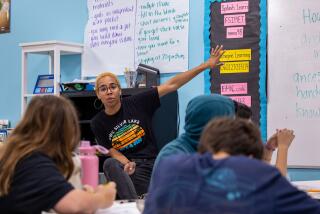To Sum Up: Hectic Day for a Small Class : Reduced Student-Teacher Ratio Forces the First-Graders to Shift Rooms at Midmorning
Only one thing worked in Jana Doros’ favor on the first day of school: The day was shorter than usual, with the dismissal bell ringing just after noon.
But nothing else about Thursday’s schedule at Reseda Elementary was accommodating, as Doros struggled to maintain her enthusiasm under less-than-ideal circumstances.
Doros, 27, who received her teaching license less than a month ago, was hired as part of the frenzied statewide effort to shrink primary grade classes to 20 students and thereby gain a share of a $971-million incentive pool.
After months of unsuccessful job-seeking, she was thankful to find herself an overnight hot commodity.
But Doros had none of the joys of decorating her first classroom, organizing her desk or even choosing a hanger for her sweater, because the interim plan for her class was a lesson in squeezing.
Her desk was a cardboard file box, her closet space one borrowed shelf. Her only bulletin board was large sheets of butcher paper temporarily push-pinned over the blackboard.
And here’s how she explained the day ahead to 19 anxious first-graders sitting cross-legged on an alphabet rug: “We’re lucky. We have not just one classroom, but two classrooms. We’ll be here in the morning and when we get bored with it, we’ll move down the hall to Room 9.”
More precisely, Doros and her students started the day in a kindergarten classroom, but had to give up those spacious quarters in midmorning when the school’s second wave of kindergartners arrived. So after recess, she herded her pupils down the hallway into teacher Debbie Almo Vazquez’s bilingual classroom, where the two struggled to calm the chaos that 40 6-year-olds can create.
Doros’ predicament was not accidental, but the result of a plan to wedge one more classroom onto the already crowded campus. Elsewhere around the 460-student school, a second-grade class met in the library and another first-grade class in the preschool.
But what no doubt appeared reasonable during an August brainstorming session was marred Thursday by the combined confusion of the first day of school, the nervousness of a new teacher and the apprehension of young children thrown into a new and unsettling situation.
One 6-year-old girl, for instance, had trouble adjusting to change and sobbed at each transition. Derik Wilson, a newcomer to the school, couldn’t stop thinking he’d left his well-worn backpack in the other classroom, causing him much consternation. George Fasheh, 7, set his homework folder on a desk in the kindergarten classroom and didn’t find it again until day’s end, after a panicked search.
There were long stretches of time spent in hallways and several harried trips back to the first classroom to retrieve forgotten items, including two lunches and Doros’ file box, in which she stowed the students’ essentials--crayons, pencils, erasers--all encased in individual plastic bags for easier transport and redistribution.
*
Parents knew nothing of the plan ahead of time; the few who learned about it Thursday were mollified by the discovery that their child would be in class with fewer students.
“They should’ve started this smaller class thing a long time ago,” said Charity Preston, after leaving her son in Doros’ class.
The principal hopes the disruption will be temporary and believes it is preferable to putting 40 kids in one classroom with two teachers all day, as many other schools have done. But how temporary depends on when the portable classrooms ordered by the school arrive.
Doros said she has been promised a real classroom by February. But Principal Janie Taylor said it could be eight months before portables arrive.
On the eve of school starting, Doros had finalized ambitious plans for her first day: She would teach a rhyming name game, hand out alphabet pretzels, review the classroom code of conduct and read aloud a book titled “First Grade Jitters.” But none of those lessons were taught as she wrestled against the combined forces of a shorter day--some schools have abbreviated schedules the first day or two of the year--and constant interruptions.
Instead, as the day unfolded, the students wrote their names four times, wrote the alphabet once, if they knew it, and drew two pictures. In the combined 40-student room, an attempt to turn the distribution of boys versus girls in each class into a math lesson fell short when students forgot which class they were in and some boys put their stickers in the girls’ column.
During the years she had spent preparing for this day--when she woke up after the Northridge earthquake and decided to trade bank work for teaching, when she enrolled in a teacher licensing program, when friends advised her not to smile too much at first lest she lose control of her class--never, ever did Doros imagine that her most important first lesson would be how to line up and walk single file.
“Remember,” she told the students during the excursion to their second classroom, “we’re going to do a lot of line-walking in our class. We need to do it well.”
More to Read
Sign up for Essential California
The most important California stories and recommendations in your inbox every morning.
You may occasionally receive promotional content from the Los Angeles Times.










